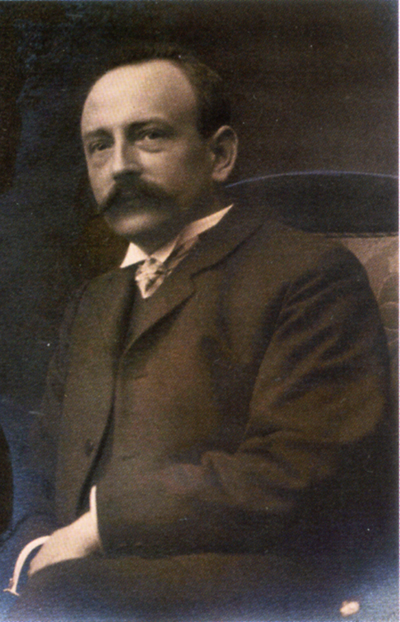
Johann Eduard Kruspe (1831-1918)

The firm of Ed. Kruspe was established in Erfurt, Germany in 1864 by Johann Eduard Kruspe (1831-1918), elder son of Carl Kruspe (1808 - 1885). |
|||||||||
Eldest son Johann Eduard Kruspe was fourteen years of age when the family moved to 15 Predigerstraße in 1845,. This address is marked as letter A in the city map of downtown Erfurt shown at right. The brass instrument maker, Carl Christian Zielsdorf was located at no. 9 Paulstraße shown as letter B on the map. Known as the "House of the Golden Unicorn" this building would later become the headquarters of Firma Ed. Kruspe. The close proximity (about a two-minute walk) and their later association suggests that young Eduard apprenticed under Zielsdorf, although that has not been confirmed.[4] |
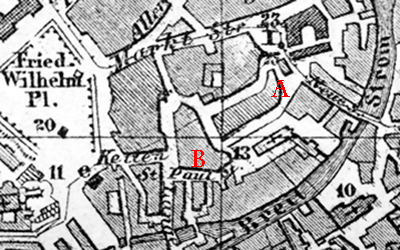 Central Erfurt in 1887 (Click for full city view) |
||||||||
An early reference to Firma Ed. Kruspe is found at the first Thuringan Industrial Exhibition held at Gotha from August 1 to September 11, 1853 when Eduard was only twenty-two. He was also also represented at the next two Thurigan Exhibitions held at Weimar in (1861) and Merseburg (1865). On January 2, 1864, a few weeks before he died, Carl Christian Zielsdorf turned the workshop at no. 9 Paulstraße over to Eduard Kruspe. Later, Firma Ed. Kruspe would advertise its founding date as June 12, 1834, referring to Zielsdorf's establishment in Erfurt.[5] |
|||||||||
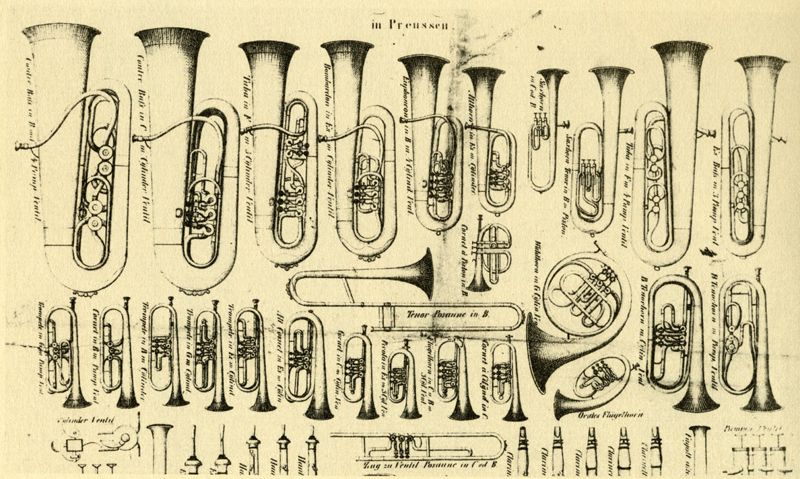 "Preiscourant der Firmen Carl und Eduard Kruspe" circa 1870, courtesy of Herbert Heyde |
|||||||||
|
|||||||||
|
|||||||||
Ernst Friedrich (Fritz) Wilhelm Kruspe was born was born December 13, 1863 in Erfurt, the son of Eduard and Dorothea Kruspe. He married Henriette Auguste Kutschmar (1873 - 1949) and together they had two children: Ilse Kruspe (1898 - 1982), who married Georg Wendler, and Walter Kruspe (1904 - 19??). When Fritz Kruspe took over the management of Firma Ed. Kruspe from his father in 1893, he began a new phase of technical developments of brass instruments. As the first technical innovation of the Fritz Kruspe Era was a new tenor/bass trombone at the suggestion of Gewandhaus trombonist, Robert Müller. It was registered as a "utility model" (D.R.G.M. 39126) on March 29, 1895, and described as "System Müller Kruspe", but seems to have found no market. [9] |
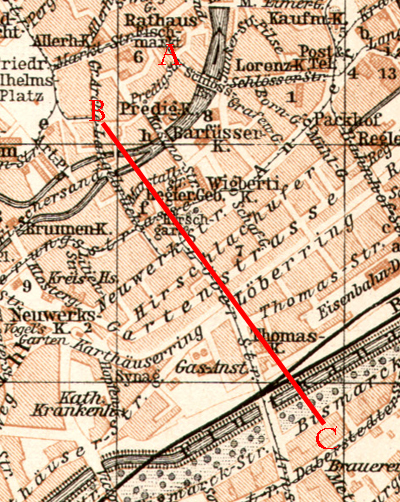 Detail of Map of
Erfurt, 1906
(click to see full map) 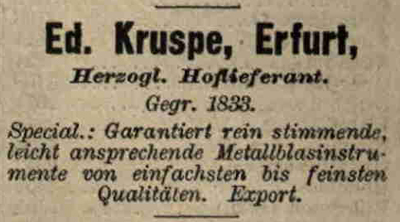 Deutsches
Reichs-Adressbuch für Industrie, Gewerbe und Handel, 1902-1903, 2. Band Deutsches
Reichs-Adressbuch für Industrie, Gewerbe und Handel, 1902-1903, 2. Band |
||||||||
|
|
|||||||||
Acknowledgments
1. Johann Heinrich Gottlieb Streitwolf was born in Göttingen on November 17, 1779, the illegitimate son of "Johann Niclas"; his mother later married a Streitwolf. From about 1797 to 1821 he was a cellist with the Akademische Orchester, a local non-professional orchestra. He later taught cello, guitar, and voice, and also composed for these instruments. He attended lectures by the eminent theorist Johann Nikolaus Forkel (1749-1818). In 1809 he commenced activity as a wind instrument maker, starting with flute, then clarinet. In 1820 his newly invented "chromatic basshorn" was favorably reviewed in AMZ. By that time he was employing "many assistants both in and out of house." From 1820 he was in close touch with the Sonderhausen court and the clarinettist there Hermstedt, for whom he built clarinets. As indicated by house purchases in 1823 and 1825 he became increasingly prosperous. In 1828 his first bass clarinet was bought by Fürst Günther von Sonderhausen. In 1835 he was awarded a medal by the Hannover Gerwerbe-Verein (trade association) for his bass clarinet. His last years were clouded by illness and he died in Göttingen on February 14, 1837.
(back)
2. Langer (2012, p.9) states that the establishment in Mühlhausen in 1829 is based on "unconfirmed information" (unbestätigten Angaben) citing Welt-Adreßbuch der gesammten Musikinstrumenten-Industrie, 1912, p. 11. The obituary for Carl's second son and successor, Friedrich Wihlem Kruspe, in Zeitschrift für Instrumentenbau v. 32, 1911-12, pp. 152-154, gives the same date.
(back)
3. The Royal Court of Schwarzburg-Sondershausen clearly favored the firm of C. Kruspe. Günther Friedrich Carl I (1760-1837), who ruled until 1835, was avid clarinet player. He was in contact with Carl Kruspe's teacher Streitwolf (see note 1, above), and possessed some of his instruments, including one of the first basset clarinets from 1828.
(back)
4. Carl Zielsdorf was born in 1799 in Wittenberg and became a resident of Erfurt in 1828. He initially established his workshop in about 1833 or 1834 (both dates are cited by Firma Kruspe), at No. 29 Paulstraße (then 2363) belonging to the shoemaker Wilhelm Weberstedt. In 1836 he purchased the building at No. 9 Paulstraße known as the "House of the Golden Unicorn." Nothing is handed down about Zielsdorf's career, and the only known example of his work is a soprano trombone in the Deutsches Museum, Munich.
(back)
5. Of course Eduard Kruspe was only three years old in 1834 and his father had not yet even established himself in Erfurt, yet in 1934 the company celebrated its one-hundred-year jubilee. See also the advertisement from 1902-1903 accompanying the text above giving the founding date as 1833.
(back)
6. In Germany, the oak tree stood for traditional values such as truth, longevity, and loyalty, and in the eighteenth and nineteenth centuries it came to symbolize Germany itself. The playwright and poet, Friedrich Gottlieb Klopstock, (1724 - 1803) hailed it as a national symbol in his play, Hermanns Schlacht: "You are the thickest, shadiest oak...the highest, oldest, most sacred oak, O fatherland." Oak leaves are a prominent symbol on most German military orders. For example, in 1813 Frederick William III, King of Prussia, added a spray of gilt oak leaves to his kingdom's highest military honor, the Pour le Mérite ("Blue Max") as an additional distinction. At that time Erfurt where this horn was made was a city in the Province of Saxony within the Kingdom of Prussia. Oak trees are common in the region and a 350-year-old oak tree still stands inside the Natural History Museum in Erfurt.
(back)
7. Bernhard Eduard Müller was born June 2, 1842 in Altenburg / Thuringia, the son of a cooper, Wilhelm Hermann Müller. He was a member of the Gewandhaus Orchestra in Leipzig as second horn (with Friedrich Adolf Gumpert as a principal) from October 1, 1876 until 1920. He is possibly the same Müller that was employed in the court orchestra in Schwerin, from 1872 to 1874. He remembered primarily for his etudes for horn, however he also composed numerous chamber pieces, including horn quartets, the Kaiser Quartets for Cornet à Piston, and a serenade for horn, flute and piano.
(back)
8. The award for four trumets went to F.A. Heckel, Dresden and the award for one B-Bsss went to V.F. Cerveny & Söhne, Königgrätz, Bohemia.
(back)
8. Tenor-, Bafs-Posaune mit Ventil unterhalb des Mundstücks und parallel mit dem Posaunenzug laufendem Ventilzug [ Tenor-, bass-trombone with valve below the mouthpiece and valve slide running parallel with the trombone slide].
(back)
References
Heyde, Herbert. Das Ventilblasinstrument, Seine Entwicklun im deutschsprachigen Raum von den Anfängen bis zur Gegenwart. Wiesbaden: Breitkopf & Härtel, 1987. ISBN 3765102253
Langer, Arne; Wenke, Wolfgang. Musikinstrumente von Weltrang, Die Firma Kruspe in Erfurt, Stadmuseum and Theaterr, Erfurt, 2012
Waterhouse, William. The New Langwill Index of Wind Instrument Makers and Inventors, pub.Tony Bingham, London 1993
Home Send eMail to Dick MartzContents of this site and all original photographs copyright 1999-2011, Richard J.Martz All rights reserved.